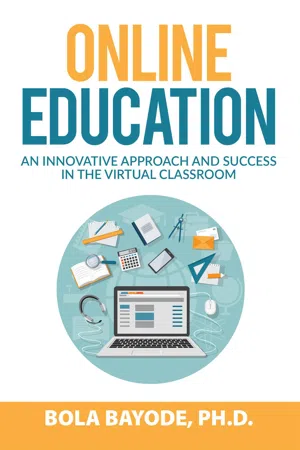
eBook - ePub
Available until 7 Jul |Learn more
Online Education
An Innovative Approach and Success in the Virtual Classroom
This book is available to read until 7th July, 2026
- English
- ePUB (mobile friendly)
- Available on iOS & Android
eBook - ePub
Available until 7 Jul |Learn more
About this book
Online education has surpassed all expectations, given its exponential growth in the last few years. Not only has the number of students who take online courses increased, but the number of educational institutions that offer online programs has skyrocketed. The dilemma facing many institutions today is not whether to have an online education, but how to integrate the pedagogy into their academic programs. Many books have addressed online education from the vantage point of instructors and administrators. But this unique volume provides the strategies that students can apply to succeed in a virtual classroom. This book also addresses emerging issues in online education and how technologies will impact higher education in the future.
Frequently asked questions
Yes, you can cancel anytime from the Subscription tab in your account settings on the Perlego website. Your subscription will stay active until the end of your current billing period. Learn how to cancel your subscription.
No, books cannot be downloaded as external files, such as PDFs, for use outside of Perlego. However, you can download books within the Perlego app for offline reading on mobile or tablet. Learn more here.
Perlego offers two plans: Essential and Complete
- Essential is ideal for learners and professionals who enjoy exploring a wide range of subjects. Access the Essential Library with 800,000+ trusted titles and best-sellers across business, personal growth, and the humanities. Includes unlimited reading time and Standard Read Aloud voice.
- Complete: Perfect for advanced learners and researchers needing full, unrestricted access. Unlock 1.4M+ books across hundreds of subjects, including academic and specialized titles. The Complete Plan also includes advanced features like Premium Read Aloud and Research Assistant.
We are an online textbook subscription service, where you can get access to an entire online library for less than the price of a single book per month. With over 1 million books across 1000+ topics, we’ve got you covered! Learn more here.
Look out for the read-aloud symbol on your next book to see if you can listen to it. The read-aloud tool reads text aloud for you, highlighting the text as it is being read. You can pause it, speed it up and slow it down. Learn more here.
Yes! You can use the Perlego app on both iOS or Android devices to read anytime, anywhere — even offline. Perfect for commutes or when you’re on the go.
Please note we cannot support devices running on iOS 13 and Android 7 or earlier. Learn more about using the app.
Please note we cannot support devices running on iOS 13 and Android 7 or earlier. Learn more about using the app.
Yes, you can access Online Education by Bayode Ph.D Bola in PDF and/or ePUB format, as well as other popular books in Education & Education General. We have over one million books available in our catalogue for you to explore.
Information
1
ONLINE EDUCATION AND THE INTERNET
Learning Objectives: After studying this chapter, you should be able to:
- Understand the elements of online education
- Examine the nature of distance education
- Discuss the origins of the Internet
- Understand the impact of the Internet on education
INTRODUCTION
Distance education has metamorphosed since the learning technique became part of the instructional method over a century ago. Not only has its mode of delivery changed, but its terminology has evolved several times as well. The term has morphed from home study or correspondence study to distance education. In recent years, descriptions such as online education, online learning, e-learning, or web-based learning have become popular. Despite the evolution in terminology and the delivery method, the objective of distance education in meeting the needs of students who cannot take courses in a face-to-face environment has doggedly remained the same. Correspondingly, authors have interchangeably applied these terminologies to mean the same thing as it will be the case throughout this book.

Chapter one provides the background to the major issues addressed in this book. In this chapter, we examine the nature of distance education and how it has altered the way students learn and transformed how education institutions deliver their academic programs. We also look at the origin of the Internet and the impact on education.
The Nature of Distance Education
Distance education has become a viable alternative to face-to-face learning, given the number of students who take their courses online and the number of educational institutions that offer online programs. In 2017, despite the decline in the overall post-secondary enrollments in the United States, the number of college students who took online classes grew. The number of students who took at least one class online grew from 31.1% in 2016 to 33.1% in 2017, and students who took blended courses (online and face-to-face courses) increased from 16.4% in 2016 to 17.6% in 2017. Among all institutions, public and private nonprofit colleges and universities experienced a two-percentage-point increase in the number of students who studied online, and schools that previously did not offer online program increased their online course enrollments.1

The Center for Digital Education (CDE) found that increased student interest is driving e-learning adoption. Although engagement vary between K-12 and higher education, 65% of tertiary institutions cited student demand and expectation as the primary factor for technology adoption, and other significant factors included instructor demand, improving student engagement, preparing students for the future and increasing student achievement.2
The e-learning market is expanding and rapidly growing as the worldwide market for online education reached $35.6 billion in 2011. The five-year compound annual growth rate (CAGR) estimated at around 7.6% puts the revenue in the sector at $51.5 billion by 2016 and the learning management system (LMS) market expected to grow by 23.17% between 2017 and 2018.3 In 2018, the e-learning market was valued at $190 billion and predicted to increase at a CAGR of 7% from 2019 to 2025.4
The full adoption and recognition of technology for teaching and training has fast-tracked the development of learning management systems. Emerging technologies such as augmented reality (AR) and virtual reality (VR) devices, artificial intelligence (AI), Big Data, machine learning, and wearable devices will further expand the e-learning market. Access to e-learning materials will be instantaneous because cloud-based technologies will replace conventional learning systems and eliminates the need to download and install specific software applications before taking an online course.5
The Early Stage of Distance Education
Distance education has been around for many centuries. Although historians traced the genesis of distance education to the Roman Empire period, its wide adoption in the academic environment began about 200 years ago. At the start of distance learning, students hardly had any interactions with their classmates and the opportunity to challenge the concepts taught in class. Students were primarily empty vessels into which professors poured knowledge. For decades, schools offered courses in shorthand, secretariat studies, accounting, commerce, law, and other vocational subjects. As distance education became popular, educational institutions extended course offerings to science, technology, humanities, and other disciplines. Today, distance learning has gone mainstream that education institutions deliver most courses online, from basic subjects that require little academic rigor, to advanced courses that involve complex analyses and higher-order thinking.
From the mid-1800s to the early 1900s, students received lectures primarily by correspondence (the mailing of course materials and receiving feedback through the post office) and used the same method to communicate with their schools. As society became advanced, educational institutions introduced the radio, television, audio-tapes, cartridges, cassettes, videotapes, and CD-ROMs to complement correspondence that had become deficient in meeting the needs of students. Suffices to say, these electronic devices provided some relief to students, but they did not go far enough to reduce their frustrations because the tools could only handle one-way communication at a given time. Students had to wait for several weeks before receiving their educational materials and the feedback they desperately needed from their professors.
In the early 1990s, there was a paradigmatic shift in distance education due to the exponential growth of the Internet. The new technology recalibrated not only the way students learn but how they communicate with their classmates and instructors.
Origins of the Internet
The Internet is a collection of loosely connected networks that are accessible by individual computer hosts, in a variety of ways, and available to anyone with a computer and a network connection anywhere in the world.6 The history of the Internet began in the early 1960s due to the concerns that the U.S. Department of Defense (DoD) had about the possible effects of a nuclear attack on its computing facilities. On the 6th of December 1967, DoD awarded a contract to the Advanced Research Projects Agency (ARPA) to study and design a computer network that could respond to the perceived threat of scientific and technological advantage the then Soviet Union exhibited when it launched the Sputnik Satellite to the orbit. ARPA hired the best brainpower in computing technology at the leading U.S. universities and research institutions and funded the project for many years.7
In an unrelated initiative but proved to be momentous, as ARPA was working on the DOD network project, a RAND (a contraction of Research and Development) researcher, Paul Baran, was working on a classified U.S. Air Force contract. The project involved ways to strengthen the U.S telecommunication infrastructure so that it could survive a nuclear attack. RAND was also building telecommunication networks around the world that could send information through multiple channels instead of a central computer system, so the Network could function if parts of it were damaged or sabotaged by the enemy.8
In 1969, the researchers at the ARPA had a breakthrough when the Advanced Research Projects Agency Network (ARPANET) they developed connected four computers at Stanford University, University of California, Los Angeles (UCLA), University of California, Santa Barbara (UC-Santa Barbara), and the University of Utah. The network later became the framework for developing the Internet.9
ARPA achieved its primary objective within two years when the agency designed a system that could control the weapons systems and transferred files, but other uses for the network emerged in the early 1970s. In 1971, Raymond (Ray) Samuel Tomlinson, a researcher at ARPA, made improvements to the local inter-user mail program the Send Message (SNDMSG) command when he used the program to compose and send a message to himself and other users’ mailboxes from another ARPANET computer.10 In no time, many military and education research communities embraced the communication method, and other stakeholders used the networking system to transfer files and access computer remotely.11
Despite the success that ARPA achieved in connecting multiple computers, its mission of developing standardized protocols to guide p...
Table of contents
- Cover
- Title Page
- Copyright
- Contents
- Preface
- Organization of This Book
- 1. Online Education and the Internet
- 2. The History of Distance Education
- 3. Online Education Definitions and Taxonomies
- 4. Online Education Formats
- 5. The Growth of Online Education
- 6. The Emerging Trends in Online Education
- 7. Online Education Technologies
- 8. Benefits of Online Education
- 9. Challenges of Online Education
- 10. Strategies for Success in the Online Environment
- 11. Best Practices in Online Education
- 12. The Future of Higher Education
- Credits
- Glossary
- Acronyms
- References
- Index
- About the Author